Design, Synthesis and Biochemical Evaluation of Novel Selective Estrogen Receptor Ligand Conjugates Incorporating an Endoxifen-Combretastatin Hybrid Scaffold
Abstract
:1. Introduction
2. Experimental Section
2.1. Chemistry
2.1.1. 4-{1-[4-(tert-Butyldimethylsilanyloxy)phenyl]-2-phenylbut-1-enylphenol 5
2.1.2. 4-{1,2-Bis-[4-(tert-butyldimethylsilanyloxy)phenyl]but-1-enyl}phenol 6
2.1.3. (4-{1-[4-(2-Bromoethoxy)phenyl]-2-phenylbut-1-enyl}phenoxy)-tert-butyldimethylsilane 7
2.1.4. [2-(4-{1,2-Bis-[4-(tert-butyldimethylsilanyloxy)phenyl]but-1-enyl}phenoxy)ethyl] bromide 8
2.1.5. [2-(4-{1-[4-(tert-Butyldimethylsilanyloxy)phenyl]-2-phenylbut-1-enyl}phenoxy)ethyl]methylamine 9
2.1.6. [2-(4-{1,2-Bis-[4-(tert-butyldimethylsilanyloxy)phenyl]but-1-enyl}phenoxy)ethyl]methylamine 10
2.1.7. 4-{1-[4-(2-Methylaminoethoxy)phenyl]-2-phenylbut-1-enyl}phenol 11 (Endoxifen)
2.1.8. 4-(1-(4-(2-(Methylamino)ethoxy)phenyl)-2-(4-hydroxyphenyl)but-1-enyl)phenol 12
2.1.9. (E)-3-(3-Amino-4-methoxyphenyl)-2-(3,4,5-trimethoxyphenyl)acrylic acid 16
2.1.10. General Method for Synthesis of Acrylic Acids 17–20, 22
2.1.11. (E)-3-(4-Bromophenyl)-2-(3,4,5-trimethoxyphenyl)acrylic Acid 17
2.1.12. (E)-3-(4-Fluorophenyl)-2-(3,4,5-trimethoxyphenyl)acrylic acid 18
2.1.13. (E)-3-p-Tolyl-2-(3,4,5-trimethoxyphenyl)acrylic acid 19
2.1.14. (E)-3-(4-Methylsulfanylphenyl)-2-(3,4,5-trimethoxyphenyl)acrylic acid 20
2.1.15. (E)-3-Naphthalen-2-yl-2-(3,4,5-trimethoxyphenyl)acrylic acid 22
2.1.16. General Method for Synthesis of Endoxifen-Acrylic Acid Conjugates 27–46
2.1.17. (E)-3-(3-Hydroxy-4-methoxyphenyl)-N-(2-{4-[(E/Z)-1-(4-hydroxyphenyl)-2-phenylbut-1-enyl]phenoxy}ethyl)-N-methyl-2-(3,4,5-trimethoxyphenyl) acrylamide 27
2.1.18. (E)-N-(2-{4-[(E/Z)-1,2-Bis-(4-hydroxyphenyl)but-1-enyl]-phenoxy}ethyl)-3-(3-hydroxy-4-methoxyphenyl)-N-methyl-2-(3,4,5-trimethoxyphenyl)acrylamide 28
2.1.19. (E)-N-(2-{4-[(E/Z)-1-(4-Hydroxyphenyl)-2-phenylbut-1-enyl]phenoxy}-ethyl)-3-(4-methoxyphenyl)-N-methyl-2-(3,4,5-trimethoxyphenyl)acrylamide 29
2.1.20. (E)-N-(2-{4-[(E/Z)-1,2-Bis-(4-hydroxyphenyl)but-1-enyl]phenoxy}ethyl)-3-(4-methoxyphenyl)-N-methyl-2-(3,4,5-trimethoxyphenyl)acrylamide 30
2.1.21. (E)-N-(2-{4-[(E/Z)-1-(4-Hydroxyphenyl)-2-phenylbut-1-enyl]phenoxy}ethyl)-2-(4-methoxyphenyl)-N-methyl-3-(3,4,5-trimethoxyphenyl) acrylamide 31
2.1.22. (E)-N-(2-{4-[(E/Z)-1,2-Bis-(4-hydroxyphenyl)but-1-enyl]phenoxy}ethyl)-2-(4-methoxyphenyl)-N-methyl-3-(3,4,5-trimethoxyphenyl)acrylamide 32
2.1.23. (E)-3-Benzo[1,3]dioxol-5-yl-N-(2-{4-[(E/Z)-1-(4-hydroxyphenyl)-2-phenylbut-1-enyl]phenoxy}ethyl)-2-(4-methoxyphenyl)-N-methylacrylamide 33
2.1.24. (E)-3-Benzo[1,3]dioxol-5-yl-N-(2-{4-[(E/Z)-1,2-bis-(4-hydroxyphenyl)but-1-enyl]phenoxy}ethyl)-2-(4-methoxyphenyl)-N-methylacrylamide 34
2.1.25. (E)-N-(2-{4-[(E/Z)-1-(4-Hydroxyphenyl)-2-phenylbut-1-enyl]phenoxy}ethyl)-N-methyl-3-naphthalen-2-yl-2-(3,4,5-trimethoxyphenyl) acrylamide 35
2.1.26. (E)-N-(2-{4-[(E/Z)-1,2-Bis-(4-hydroxyphenyl)but-1-enyl]phenoxy}ethyl)-N-methyl-3-naphthalen-2-yl-2-(3,4,5-trimethoxyphenyl)acrylamide 36
2.1.27. (E)-N-(2-{4-[(E/Z)-1-(4-Hydroxyphenyl)-2-phenylbut-1-enyl]phenoxy}ethyl)-N-methyl-3-p-tolyl-2-(3,4,5-trimethoxyphenyl)acrylamide 37
2.1.28. (E)-N-(2-{4-[(E/Z)-1,2-Bis-(4-hydroxyphenyl)but-1-enyl]phenoxy}ethyl)-N-methyl-3-p-tolyl-2-(3,4,5-trimethoxyphenyl)acrylamide 38
2.1.29. (E)-N-(2-{4-[(E/Z)-1-(4-Hydroxyphenyl)-2-phenylbut-1-enyl]phenoxy}ethyl)-N-methyl-3-(4-methylsulfanylphenyl)-2-(3,4,5-trimethoxyphenyl) acrylamide 39
2.1.30. (E)-N-(2-{4-[(E/Z)-1,2-Bis-(4-hydroxyphenyl)but-1-enyl]phenoxy}ethyl)-N-methyl-3-(4-methylsulfanylphenyl)-2-(3,4,5-trimethoxyphenyl)acrylamide 40
2.1.31. (E)-3-(4-Bromophenyl)-N-(2-{4-[(E/Z)-1-(4-hydroxyphenyl)-2-phenylbut-1-enyl]phenoxy}ethyl)-N-methyl-2-(3,4,5-trimethoxyphenyl)acrylamide 41
2.1.32. (E)-N-(2-{4-[(E/Z)-1,2-Bis-(4-hydroxyphenyl)but-1-enyl]phenoxy}ethyl)-3-(4-bromophenyl)-N-methyl-2-(3,4,5-trimethoxyphenyl)acrylamide 42
2.1.33. (E)-3-(3-Fluoro-4-methoxyphenyl)-N-(2-{4-[(E/Z)-1-(4-hydroxyphenyl)-2-phenylbut-1-enyl]phenoxy}ethyl)-N-methyl-2-(3,4,5-trimethoxyphenyl) acrylamide 43
2.1.34. (E)-N-(2-{4-[(E/Z)-1,2-Bis-(4-hydroxyphenyl)but-1-enyl]phenoxy}ethyl)-3-(3-fluoro-4-methoxyphenyl)-N-methyl-2-(3,4,5-trimethoxyphenyl)acrylamide 44
2.1.35. (E)-3-(3-Amino-4-methoxyphenyl)-N-(2-{4-[(E/Z)-1-(4-hydroxyphenyl)-2-phenylbut-1-enyl]phenoxy}ethyl)-N-methyl-2-(3,4,5-trimethoxyphenyl) acrylamide 45
2.1.36. (E)-3-(3-Amino-4-methoxyphenyl)-N-(2-{4-[(E/Z)-1,2-bis-(4-hydroxyphenyl)but-1-enyl]phenoxy}ethyl)-N-methyl-2-(3,4,5-trimethoxyphenyl) acrylamide 46
2.1.37. (E)-2-(4-Methoxyphenyl)-1-(piperidin-1-yl)-3-(3,4,5-trimethoxyphenyl)prop-2-en-1-one 47
2.1.38. (E)-2-(4-methoxyphenyl)-1-(pyrrolidin-1-yl)-3-(3,4,5-trimethoxyphenyl)prop-2-en-1-one 48
2.1.39. (E)-3-(3-hydroxy-4-methoxyphenyl)-1-(piperidin-1-yl)-2-(3,4,5-trimethoxyphenyl)prop-2-en-1-one 49
2.1.40. (E)-3-(4-Methoxy-3-nitrophenyl)-1-(piperidin-1-yl)-2-(3,4,5-trimethoxyphenyl)prop-2-en-1-one 50
2.1.41. (E)-3-(4-Methoxy-3-nitrophenyl)-1-(pyrrolidin-1-yl)-2-(3,4,5-trimethoxyphenyl)prop-2-en-1-one 51
2.1.42. (E)-3-(4-Methoxyphenyl)-1-(pyrrolidin-1-yl)-2-(3,4,5-trimethoxyphenyl)prop-2-en-1-one 52
2.1.43. (E)-3-(4-Methoxyphenyl)-1-(piperidin-1-yl)-2-(3,4,5-trimethoxyphenyl)prop-2-en-1-one 53
2.1.44. (E)-3-(3-Amino-4-methoxyphenyl)-1-(pyrrolidin-1-yl)-2-(3,4,5-trimethoxyphenyl)prop-2-en-1-one 54
2.1.45. (E)-3-(3-Amino-4-methoxyphenyl)-1-(piperidin-1-yl)-2-(3,4,5-trimethoxyphenyl)prop-2-en-1-one 55
2.1.46. Stability Study for Compounds 27, 31 and 32
2.2. Biochemical Evaluation
2.2.1. MTT Assay for Measurement of Antiproliferative Effects in MCF-7 and MDA-MB-231 Cell Lines
2.2.2. Lactate Dehydrogenase Assay for Measurement of Cytotoxicity
2.2.3. Estrogen Receptor Fluorescent Polarisation Assay
2.2.4. Ishikawa Cell Line Study
2.2.5. NCI One-Dose and Five-Dose Screen Output
2.3. Molecular Modelling
3. Results
3.1. Synthesis of Endoxifen-Combretastatin Conjugates
3.2. Biochemical Studies
3.2.1. Antiproliferation and Cytotoxicity Studies
3.2.2. Estrogen Receptor Binding
3.2.3. NCI 60 Cell Line Screen
3.2.4. Ishikawa Cell Line Study
3.2.5. Stability Studies
3.3. Molecular Modelling
4. Conclusions
Acknowledgments
Author Contributions
Conflicts of Interest
References
- Ascenzi, P.; Bocedi, A.; Marino, M. Structure-function relationship of estrogen receptor alpha and beta: Impact on human health. Mol. Asp. Med. 2006, 27, 299–402. [Google Scholar] [CrossRef] [PubMed]
- Powles, T.J. Anti-oestrogenic prevention of breast cancer—The make or break point. Nat. Rev. Cancer 2002, 2, 787–794. [Google Scholar] [CrossRef] [PubMed]
- Jordan, V.C. Antiestrogens and selective estrogen receptor modulators as multifunctional medicines. 1. Receptor interactions. J. Med. Chem. 2003, 46, 883–908. [Google Scholar] [CrossRef] [PubMed]
- Jordan, V.C. Antiestrogens and selective estrogen receptor modulators as multifunctional medicines. 2. Clinical considerations and new agents. J. Med. Chem. 2003, 46, 1081–1111. [Google Scholar] [CrossRef] [PubMed]
- Meegan, M.J.; Lloyd, D.G. Advances in the science of estrogen receptor modulation. Curr. Med. Chem. 2003, 10, 181–210. [Google Scholar] [CrossRef] [PubMed]
- Dodge, J.A.; Richardson, T.I. Novel selective estrogen receptor modulators (serms). Annu. Rep. Med. Chem. 2007, 42, 147–160. [Google Scholar]
- Keely, N.O.; Meegan, M.J. Selective estrogen receptor modulators: Recent developments in design, structural studies and clinical applications. Curr. Trends Med. Chem. 2009, 6, 1–17. [Google Scholar]
- Jordan, V.C. New insights into the metabolism of tamoxifen and its role in the treatment and prevention of breast cancer. Steroids 2007, 72, 829–842. [Google Scholar] [CrossRef] [PubMed]
- Pasqualini, J.R.; Chetrite, G.S. Recent insight on the control of enzymes involved in estrogen formation and transformation in human breast cancer. J. Steroid Biochem. Mol. Biol. 2005, 93, 221–236. [Google Scholar] [CrossRef] [PubMed]
- Scott, S.M.; Brown, M.; Come, S.E. Emerging data on the efficacy and safety of fulvestrant, a unique antiestrogen therapy for advanced breast cancer. Expert Opin. Drug Saf. 2011, 10, 819–826. [Google Scholar] [CrossRef] [PubMed]
- O’Boyle, N.M.; Pollock, J.K.; Carr, M.; Knox, A.J.; Nathwani, S.M.; Wang, S.; Caboni, L.; Zisterer, D.M.; Meegan, M.J. Beta-lactam estrogen receptor antagonists and a dual-targeting estrogen receptor/tubulin ligand. J. Med. Chem. 2014, 57, 9370–9382. [Google Scholar] [CrossRef] [PubMed]
- Jaracz, S.; Chen, J.; Kuznetsova, L.V.; Ojima, I. Recent advances in tumor-targeting anticancer drug conjugates. Bioorgan. Med. Chem. 2005, 13, 5043–5054. [Google Scholar] [CrossRef] [PubMed]
- Morphy, R.; Rankovic, Z. Designed multiple ligands. An emerging drug discovery paradigm. J. Med. Chem. 2005, 48, 6523–6543. [Google Scholar] [CrossRef] [PubMed]
- Keely, N.O.; Meegan, M.J. Targeting tumors using estrogen receptor ligand conjugates. Curr. Cancer Drug Targets 2009, 9, 370–380. [Google Scholar] [CrossRef] [PubMed]
- Dao, K.L.; Hanson, R.N. Targeting the estrogen receptor using steroid-therapeutic drug conjugates (hybrids). Bioconjug. Chem. 2012, 23, 2139–2158. [Google Scholar] [CrossRef] [PubMed]
- Keely, N.O.; Zisterer, D.M.; Meegan, M.J. Design, synthesis and biochemical evaluation of estrogen receptor ligand conjugates as tumor targeting agents. Lett. Drug Des. Discov. 2012, 9, 295–304. [Google Scholar] [CrossRef]
- Burke, P.J.; Koch, T.H. Design, synthesis, and biological evaluation of doxorubicin-formaldehyde conjugates targeted to breast cancer cells. J. Med. Chem. 2004, 47, 1193–1206. [Google Scholar] [CrossRef] [PubMed]
- Knebel, N.; von Angerer, E. Platinum complexes with binding affinity for the estrogen receptor. J. Med. Chem. 1988, 31, 1675–1679. [Google Scholar] [CrossRef] [PubMed]
- Vogel, A.I.; Tatchell, A.R.; Furnis, B.S.; Hannaford, A.J.; Smith, P.W.G. Vogel’s Textbook of Practical Organic Chemistry, 5th ed.; Prentice Hall: Englewood Cliffs, NJ, USA, 1996. [Google Scholar]
- Pettit, G.R.; Singh, S.B.; Boyd, M.R.; Hamel, E.; Pettit, R.K.; Schmidt, J.M.; Hogan, F. Antineoplastic agents. 291. Isolation and synthesis of combretastatins A-4, A-5, and A-6(1A). J. Med. Chem. 1995, 38, 1666–1672. [Google Scholar] [CrossRef] [PubMed]
- Gaukroger, K.; Hadfield, J.A.; Hepworth, L.A.; Lawrence, N.J.; McGown, A.T. Novel syntheses of cis and trans isomers of combretastatin A-4. J. Org. Chem. 2001, 66, 8135–8138. [Google Scholar] [CrossRef] [PubMed]
- Borrel, C.; Thoret, S.; Cachet, X.; Guenard, D.; Tillequin, F.; Koch, M.; Michel, S. New antitubulin derivatives in the combretastatin a4 series: Synthesis and biological evaluation. Bioorgan. Med. Chem. 2005, 13, 3853–3864. [Google Scholar] [CrossRef] [PubMed]
- Yong, Z.; Xu, X. Preparation of 2-(3,4,5-trimethoxyphenyl)-3-phenylpropenoic acid derivatives for blood-vessel targeted-agent drugs. WO 2009059448, 4 May 2009. [Google Scholar]
- Nam, N.H.; Byung-Zun, A. Combretastatin-chalcone hybrids: Synthesis and cytotoxicity. Med. Chem. 2007, 3, 373–377. [Google Scholar] [PubMed]
- Eaddy, J.F., III; Heyer, D.; Katamreddy, S.R.; Martin, M.T.; McClure, M.S.; Randhawa, A.S.; Samano, V.; Ray, J.A. Preparation of acyloxydiphenylbutenylcinnamates as estrogen receptor modulator prodrugs. WO 2005033056, 14 April 2005. [Google Scholar]
- Hadfield, J.A.; Gaukroger, K.; Hirst, N.; Weston, A.P.; Lawrence, N.J.; McGown, A.T. Synthesis and evaluation of double bond substituted combretastatins. Eur. J. Med. Chem. 2005, 40, 529–541. [Google Scholar] [CrossRef] [PubMed]
- Lloyd, D.G.; Smith, H.M.; O’Sullivan, T.; Zisterer, D.M.; Meegan, M.J. Synthesis, structure-activity relationships and antagonistic effects in human MCF-7 breast cancer cells of flexible estrogen receptor modulators. Med. Chem. 2005, 1, 335–353. [Google Scholar] [CrossRef] [PubMed]
- Vessieres, A.; Top, S.; Pigeon, P.; Hillard, E.; Boubeker, L.; Spera, D.; Jaouen, G. Modification of the estrogenic properties of diphenols by the incorporation of ferrocene. Generation of antiproliferative effects in vitro. J. Med. Chem. 2005, 48, 3937–3940. [Google Scholar] [CrossRef] [PubMed]
- Fauq, A.H.; Maharvi, G.M.; Sinha, D. A convenient synthesis of (Z)-4-hydroxy-N-desmethyltamoxifen (endoxifen). Bioorgan. Med. Chem. Lett. 2010, 20, 3036–3038. [Google Scholar] [CrossRef] [PubMed]
- Mosmann, T. Rapid colorimetric assay for cellular growth and survival: Application to proliferation and cytotoxicity assays. J. Immunol. Methods 1983, 65, 55–63. [Google Scholar] [CrossRef]
- Prism version 4, Graphpad Software, Inc.: La Jolla, CA, USA, 2010.
- Promega Corporation, Cytotox 96® Non-Radioactive Cytotoxicity Assay; Promega Cytotox 96 Nonradioactive Cytotoxicity Assay protocol.pdf; 2016. Available online: www.promega.com (accessed on 26 April 2016).
- Polarscreen™ er Alpha Competitor Assay, Green. Available online: https://tools.Thermofisher.Com/content/sfs/manuals/polarscreen_er_alpha_green_man.Pdf (accessed on 21 March 2016).
- Polarscreen™ er Beta Competitor Assay Kit, Green. Available online: https://tools.Thermofisher.Com/content/sfs/manuals/polarscreen_er_beta_green_man.pdf (accessed on 21 March 2016).
- Littlefield, B.A.; Gurpide, E.; Markiewicz, L.; McKinley, B.; Hochberg, R.B. A simple and sensitive microtiter plate estrogen bioassay based on stimulation of alkaline phosphatase in ishikawa cells: Estrogenic action of delta 5 adrenal steroids. Endocrinology 1990, 127, 2757–2762. [Google Scholar] [CrossRef] [PubMed]
- Paull, K.D.; Shoemaker, R.H.; Hodes, L.; Monks, A.; Scudiero, D.A.; Rubinstein, L.; Plowman, J.; Boyd, M.R. Display and analysis of patterns of differential activity of drugs against human tumor cell lines: Development of mean graph and compare algorithm. J. Natl. Cancer Inst. 1989, 81, 1088–1092. [Google Scholar] [CrossRef] [PubMed]
- Meegan, M.J.; Hughes, R.B.; Lloyd, D.G.; Williams, D.C.; Zisterer, D.M. Flexible estrogen receptor modulators: Design, synthesis, and antagonistic effects in human MCF-7 breast cancer cells. J. Med. Chem. 2001, 44, 1072–1084. [Google Scholar] [CrossRef] [PubMed]
- Macromodel version 6.5.24. Schrödinger Inc.: New York, NY, USA. Available online: http://www.schrodinger.com/ (accessed on 26 April 2016).
- Omega version 2.3.2. Openeye Scientific Software, Inc.: Santa Fe, NM, USA. Available online: http://www.eyesopen.com (accessed on 22 March 2010).
- FRED version 2.2.5. Openeye Scientific Software, Inc.: Santa Fe, NM, USA. Available online: http://docs.eyesopen.com/oedocking/fred.html (accessed on 26 April 2016).
- Shiau, A.K.; Barstad, D.; Loria, P.M.; Cheng, L.; Kushner, P.J.; Agard, D.A.; Greene, G.L. The structural basis of estrogen receptor/coactivator recognition and the antagonism of this interaction by tamoxifen. Cell 1998, 95, 927–937. [Google Scholar] [CrossRef]
- Pike, A.C.; Brzozowski, A.M.; Hubbard, R.E.; Bonn, T.; Thorsell, A.G.; Engstrom, O.; Ljunggren, J.; Gustafsson, J.A.; Carlquist, M. Structure of the ligand-binding domain of oestrogen receptor beta in the presence of a partial agonist and a full antagonist. EMBO J. 1999, 18, 4608–4618. [Google Scholar] [CrossRef] [PubMed]
- Wu, X.; Hawse, J.R.; Subramaniam, M.; Goetz, M.P.; Ingle, J.N.; Spelsberg, T.C. The tamoxifen metabolite, endoxifen, is a potent antiestrogen that targets estrogen receptor alpha for degradation in breast cancer cells. Cancer Res. 2009, 69, 1722–1727. [Google Scholar] [CrossRef] [PubMed]
- Lim, Y.C.; Li, L.; Desta, Z.; Zhao, Q.; Rae, J.M.; Flockhart, D.A.; Skaar, T.C. Endoxifen, a secondary metabolite of tamoxifen, and 4-oh-tamoxifen induce similar changes in global gene expression patterns in MCF-7 breast cancer cells. J. Pharmacol. Exp. Ther. 2006, 318, 503–512. [Google Scholar] [CrossRef] [PubMed]
- Lu, W.J.; Desta, Z.; Flockhart, D.A. Tamoxifen metabolites as active inhibitors of aromatase in the treatment of breast cancer. Breast Cancer Res. Treat. 2012, 131, 473–481. [Google Scholar] [CrossRef] [PubMed]
- Lv, W.; Liu, J.; Lu, D.; Flockhart, D.A.; Cushman, M. Synthesis of mixed (E,Z)-, (E)-, and (Z)-norendoxifen with dual aromatase inhibitory and estrogen receptor modulatory activities. J. Med. Chem. 2013, 56, 4611–4618. [Google Scholar] [CrossRef] [PubMed]
- Lu, J.; Wang, X.; Xu, Y.; Dong, Y.; Yang, S.; Wu, Y.; Qin, Y.; Wu, M. Mass spectrometric characterization of toremifene metabolites in human urine by liquid chromatography-tandem mass spectrometry with different scan modes. Analyst 2011, 136, 467–472. [Google Scholar] [CrossRef] [PubMed]
- Coe, P.L.; Scriven, C.E. Crossed coupling of functionalized ketones by low valent titanium (the mcmurry reaction)—A new stereoselective synthesis of tamoxifen. J. Chem. Soc. Perkin Trans. 1 1986, 475–477. [Google Scholar] [CrossRef]
- Katzenellenbogen, J.A.; Carlson, K.E.; Katzenellenbogen, B.S. Facile geometric isomerization of phenolic non-steroidal estrogens and antiestrogens: Limitations to the interpretation of experiments characterizing the activity of individual isomers. J. Steroid Biochem. 1985, 22, 589–596. [Google Scholar] [CrossRef]
- Maximov, P.Y.; Myers, C.B.; Curpan, R.F.; Lewis-Wambi, J.S.; Jordan, V.C. Structure-function relationships of estrogenic triphenylethylenes related to endoxifen and 4-hydroxytamoxifen. J. Med. Chem. 2010, 53, 3273–3283. [Google Scholar] [CrossRef] [PubMed]
- Nam, N.H. Combretastatin A-4 analogues as antimitotic antitumor agents. Curr. Med. Chem. 2003, 10, 1697–1722. [Google Scholar] [CrossRef] [PubMed]
- Tron, G.C.; Pirali, T.; Sorba, G.; Pagliai, F.; Busacca, S.; Genazzani, A.A. Medicinal chemistry of combretastatin a4: Present and future directions. J. Med. Chem. 2006, 49, 3033–3044. [Google Scholar] [CrossRef] [PubMed]
- Parihar, S.; Kumar, A.; Chaturvedi, A.K.; Sachan, N.K.; Luqman, S.; Changkija, B.; Manohar, M.; Prakash, O.; Chanda, D.; Khan, F.; et al. Synthesis of combretastatin a4 analogues on steroidal framework and their anti-breast cancer activity. J. Steroid Biochem. Mol. Biol. 2013, 137, 332–344. [Google Scholar] [CrossRef] [PubMed]
- Cushman, M.; Nagarathnam, D.; Gopal, D.; Chakraborti, A.K.; Lin, C.M.; Hamel, E. Synthesis and evaluation of stilbene and dihydrostilbene derivatives as potential anticancer agents that inhibit tubulin polymerization. J. Med. Chem. 1991, 34, 2579–2588. [Google Scholar] [CrossRef] [PubMed]
- Cushman, M.; Nagarathnam, D.; Gopal, D.; He, H.M.; Lin, C.M.; Hamel, E. Synthesis and evaluation of analogues of (Z)-1-(4-methoxyphenyl)-2-(3,4,5-trimethoxyphenyl)ethene as potential cytotoxic and antimitotic agents. J. Med. Chem. 1992, 35, 2293–2306. [Google Scholar] [CrossRef] [PubMed]
- Pinney, K.G.; Mejia, M.P.; Villalobos, V.M.; Rosenquist, B.E.; Pettit, G.R.; Verdier-Pinard, P.; Hamel, E. Synthesis and biological evaluation of aryl azide derivatives of combretastatin a-4 as molecular probes for tubulin. Bioorgan. Med. Chem. 2000, 8, 2417–2425. [Google Scholar] [CrossRef]
- Lawrence, N.J.; Hepworth, L.A.; Rennison, D.; McGown, A.T.; Hadfield, J.A. Synthesis and anticancer activity of fluorinated analogues of combretastatin A-4. J. Fluor. Chem. 2003, 123, 101–108. [Google Scholar] [CrossRef]
- Pettit, G.R.; Rhodes, M.R.; Herald, D.L.; Hamel, E.; Schmidt, J.M.; Pettit, R.K. Antineoplastic agents. 445. Synthesis and evaluation of structural modifications of (Z)- and (E)-combretastatin A-41. J. Med. Chem. 2005, 48, 4087–4099. [Google Scholar] [CrossRef] [PubMed]
- Flynn, B.L.; Flynn, G.P.; Hamel, E.; Jung, M.K. The synthesis and tubulin binding activity of thiophene-based analogues of combretastatin A-4. Bioorgan. Med. Chem. Lett. 2001, 11, 2341–2343. [Google Scholar] [CrossRef]
- Maya, A.B.; del Rey, B.; de Clairac, R.P.L.; Caballero, E.; Barasoain, I.; Andreu, J.M.; Medarde, M. Design, synthesis and cytotoxic activities of naphthyl analogues of combretastatin A-4. Bioorgan. Med. Chem. Lett. 2000, 10, 2549–2551. [Google Scholar] [CrossRef]
- Perez-Melero, C.; Maya, A.B.; del Rey, B.; Pelaez, R.; Caballero, E.; Medarde, M. A new family of quinoline and quinoxaline analogues of combretastatins. Bioorgan. Med. Chem. Lett. 2004, 14, 3771–3774. [Google Scholar] [CrossRef] [PubMed]
- Maya, A.B.; Perez-Melero, C.; Mateo, C.; Alonso, D.; Fernandez, J.L.; Gajate, C.; Mollinedo, F.; Pelaez, R.; Caballero, E.; Medarde, M. Further naphthylcombretastatins. An investigation on the role of the naphthalene moiety. J. Med. Chem. 2005, 48, 556–568. [Google Scholar] [CrossRef] [PubMed]
- Sanchez Maya, A.B.; Perez-Melero, C.; Salvador, N.; Pelaez, R.; Caballero, E.; Medarde, M. New naphthylcombretastatins. Modifications on the ethylene bridge. Bioorgan. Med. Chem. 2005, 13, 2097–2107. [Google Scholar] [CrossRef] [PubMed]
- Olszewski, J.D.; Marshalla, M.; Sabat, M.; Sundberg, R.J. Potential photoaffinity labels for tubulin—Synthesis and evaluation of diazocyclohexadienone and azide analogs of colchicine, combretastatin, and 3,4,5-trimethoxybiphenyl. J. Org. Chem. 1994, 59, 4285–4296. [Google Scholar] [CrossRef]
- Ohsumi, K.; Nakagawa, R.; Fukuda, Y.; Hatanaka, T.; Morinaga, Y.; Nihei, Y.; Ohishi, K.; Suga, Y.; Akiyama, Y.; Tsuji, T. Novel combretastatin analogues effective against murine solid tumors: Design and structure-activity relationships. J. Med. Chem. 1998, 41, 3022–3032. [Google Scholar] [CrossRef] [PubMed]
- Bidlack, J.M.; Lockshin, R.A. Evolution of LDH isozymes during programmed cell death. Comp. Biochem. Physiol. B 1976, 55, 161–166. [Google Scholar] [CrossRef]
- Mor, G.; Sapi, E.; Abrahams, V.M.; Rutherford, T.; Song, J.; Hao, X.Y.; Muzaffar, S.; Kohen, F. Interaction of the estrogen receptors with the Fas ligand promoter in human monocytes. J. Immunol. 2003, 170, 114–122. [Google Scholar] [CrossRef] [PubMed]
- Dark, G.G.; Hill, S.A.; Prise, V.E.; Tozer, G.M.; Pettit, G.R.; Chaplin, D.J. Combretastatin A-4, an agent that displays potent and selective toxicity toward tumor vasculature. Cancer Res. 1997, 57, 1829–1834. [Google Scholar] [PubMed]
- De Martino, G.; La Regina, G.; Coluccia, A.; Edler, M.C.; Barbera, M.C.; Brancale, A.; Wilcox, E.; Hamel, E.; Artico, M.; Silvestri, R. Arylthioindoles, potent inhibitors of tubulin polymerization. J. Med. Chem. 2004, 47, 6120–6123. [Google Scholar] [CrossRef] [PubMed]
- Johnson, M.D.; Zuo, H.; Lee, K.H.; Trebley, J.P.; Rae, J.M.; Weatherman, R.V.; Desta, Z.; Flockhart, D.A.; Skaar, T.C. Pharmacological characterization of 4-hydroxy-N-desmethyl tamoxifen, a novel active metabolite of tamoxifen. Breast Cancer Res. Treat. 2004, 85, 151–159. [Google Scholar] [CrossRef] [PubMed]
- Shoemaker, R.H. The NCI 60 human tumour cell line anticancer drug screen. Nat. Rev. Cancer 2006, 6, 813–823. [Google Scholar] [CrossRef] [PubMed]
- Welcome to the Developmental Therapeutics Program. National Cancer Institute: Bethesda, MD, USA. Available online: http://dtp.Cancer.Gov (accessed on 21 March 2016).
- National Cancer Institute Biological Testing Branch. National Cancer Institute: Bethesda, MD, USA. Available online: https://dtp.Nci.Nih.Gov/branches/btb/hfa.Html (accessed on 21 March 2016).
- Leese, M.P.; Leblond, B.; Smith, A.; Newman, S.P.; Di Fiore, A.; De Simone, G.; Supuran, C.T.; Purohit, A.; Reed, M.J.; Potter, B.V. 2-substituted estradiol bis-sulfamates, multitargeted antitumor agents: Synthesis, in vitro sar, protein crystallography, and in vivo activity. J. Med. Chem. 2006, 49, 7683–7696. [Google Scholar] [CrossRef] [PubMed]
- Calvert, A.H. Fishing for new drugs. J. Clin. Oncol. 2005, 23, 7780–7782. [Google Scholar] [CrossRef] [PubMed]
- Cuendet, M.; Pezzuto, J.M. Antitumor activity of bruceantin: An old drug with new promise. J. Nat. Prod. 2004, 67, 269–272. [Google Scholar] [CrossRef] [PubMed]
- McLeod, H.L.; Murray, L.S.; Wanders, J.; Setanoians, A.; Graham, M.A.; Pavlidis, N.; Heinrich, B.; ten Bokkel Huinink, W.W.; Wagener, D.J.; Aamdal, S.; et al. Multicentre phase II pharmacological evaluation of rhizoxin. Eortc early clinical studies (ECSG)/pharmacology and molecular mechanisms (PAMM) groups. Br. J. Cancer 1996, 74, 1944–1948. [Google Scholar] [CrossRef] [PubMed]
- Tsuruo, T.; Oh-hara, T.; Iida, H.; Tsukagoshi, S.; Sato, Z.; Matsuda, I.; Iwasaki, S.; Okuda, S.; Shimizu, F.; Sasagawa, K.; et al. Rhizoxin, a macrocyclic lactone antibiotic, as a new antitumor agent against human and murine tumor cells and their vincristine-resistant sublines. Cancer Res. 1986, 46, 381–385. [Google Scholar] [PubMed]
- Wurtz, J.M.; Bourguet, W.; Renaud, J.P.; Vivat, V.; Chambon, P.; Moras, D.; Gronemeyer, H. A canonical structure for the ligand-binding domain of nuclear receptors. Nat. Struct. Biol. 1996, 3, 87–94. [Google Scholar] [CrossRef] [PubMed]
- Brzozowski, A.M.; Pike, A.C.; Dauter, Z.; Hubbard, R.E.; Bonn, T.; Engstrom, O.; Ohman, L.; Greene, G.L.; Gustafsson, J.A.; Carlquist, M. Molecular basis of agonism and antagonism in the oestrogen receptor. Nature 1997, 389, 753–758. [Google Scholar] [CrossRef] [PubMed]
- Pike, A.C.W. Lessons learnt from structural studies of the estrogen receptor. Best Pract. Res. Clin. Endocrinol. Metab. 2006, 20, 1–14. [Google Scholar] [CrossRef] [PubMed]
- Marvin Version 4.1, Chemaxon. Available online: http://www.Chemaxon.Com/ (accessed on 28 April 2016).
- Ds Visualizer Version 1.7. Accelyrs Software, Inc.: San Diego, CA, USA. Available online: http://accelrys.Com/products/discovery-studio/visualization/ (accessed on 26 April 2016).
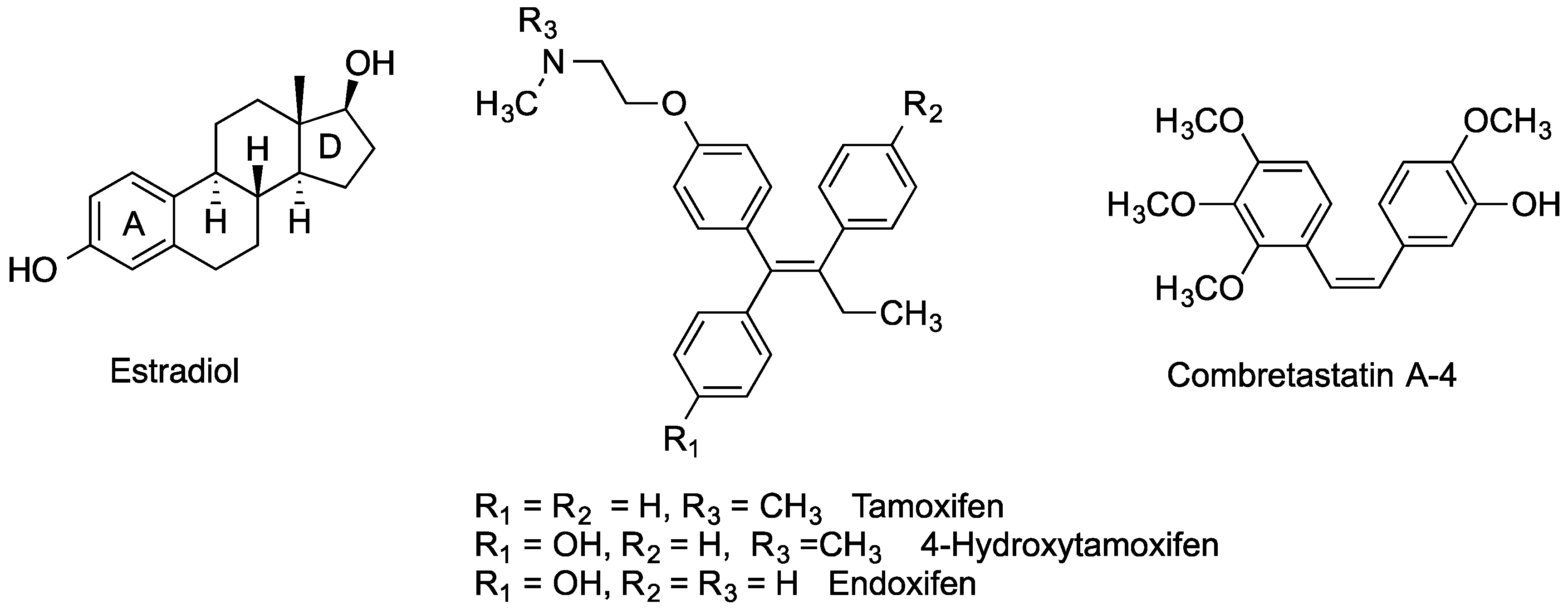
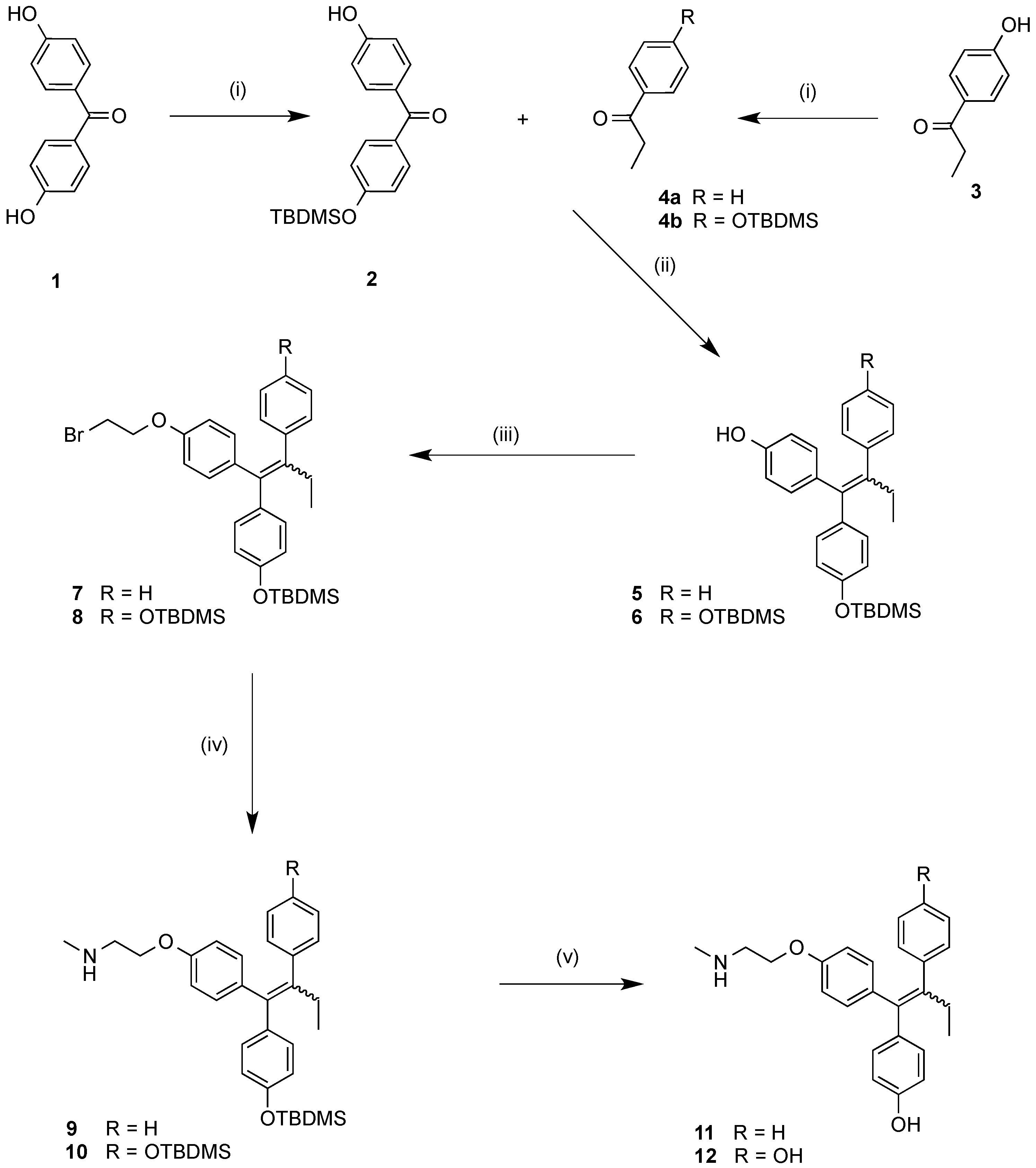
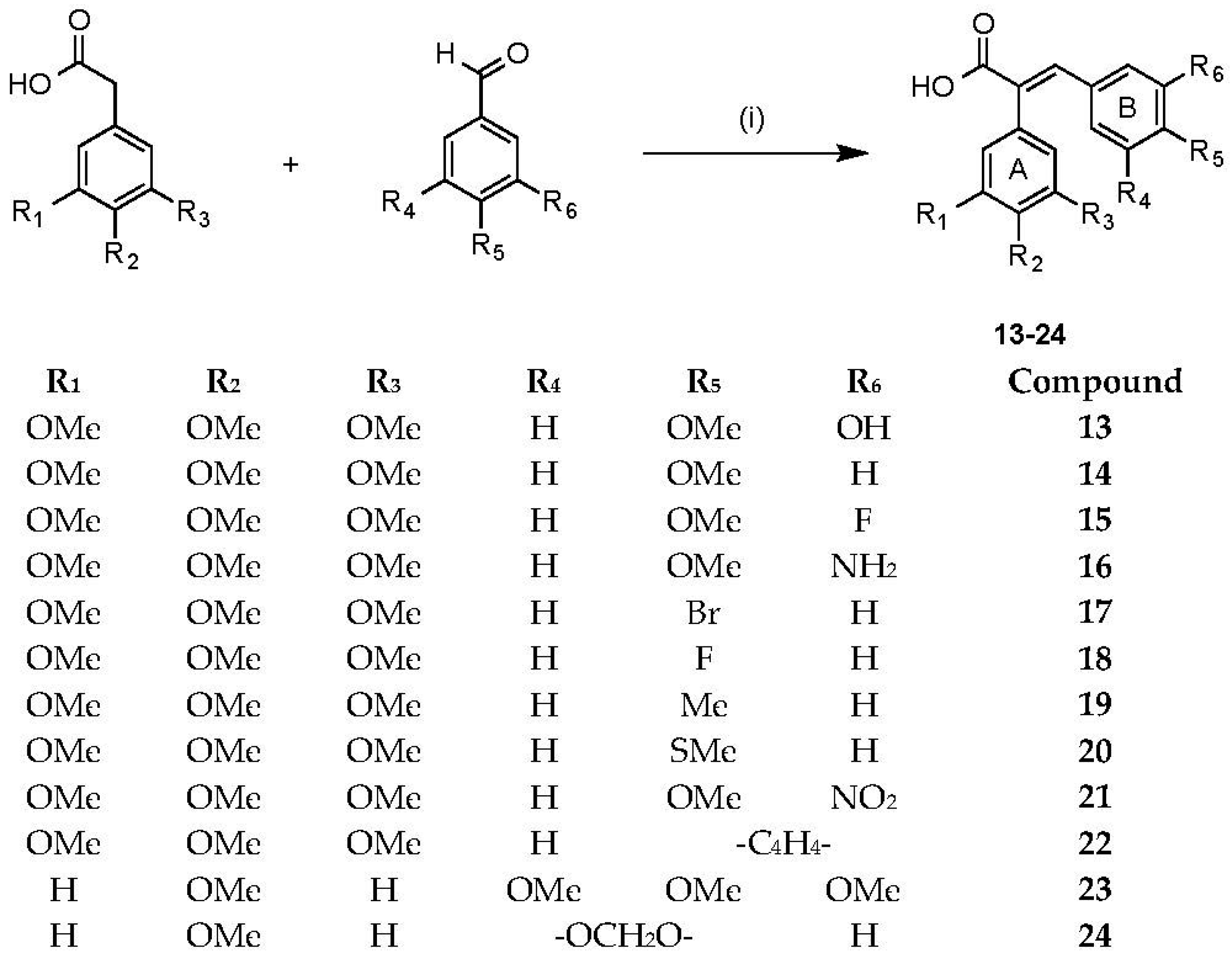

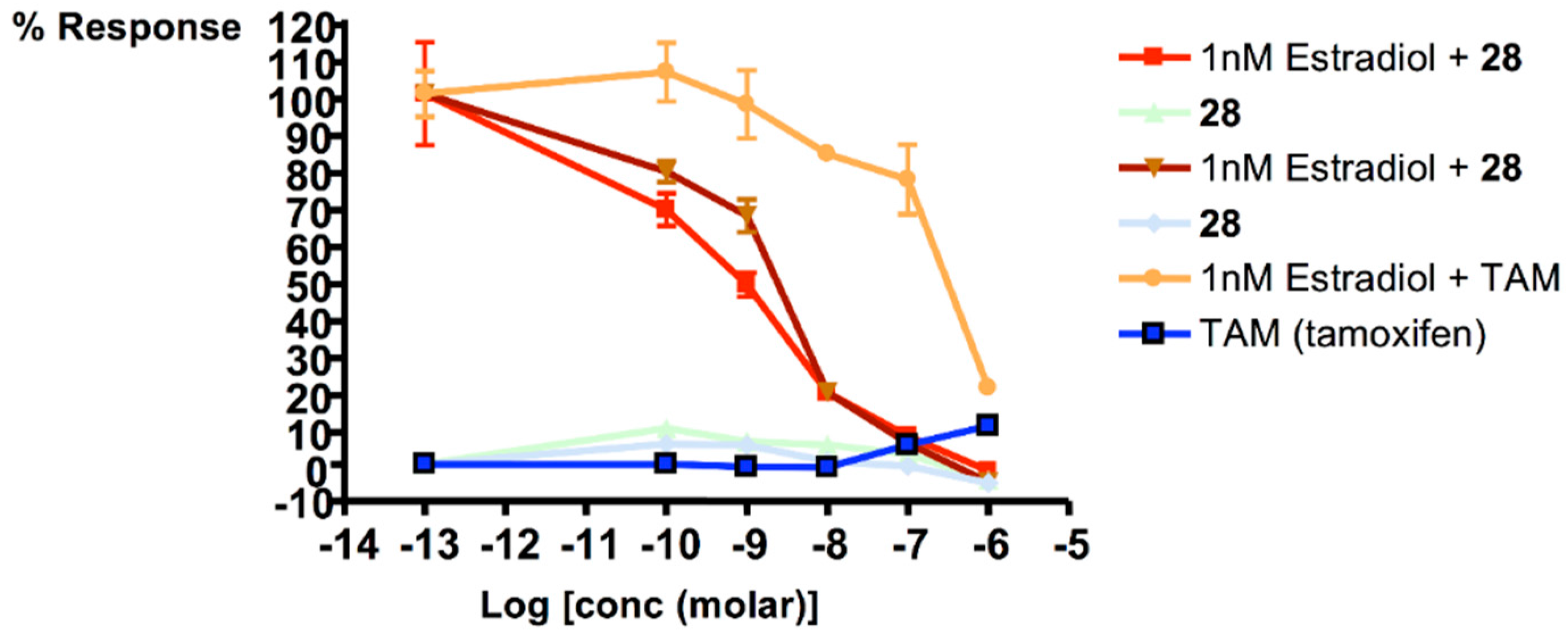

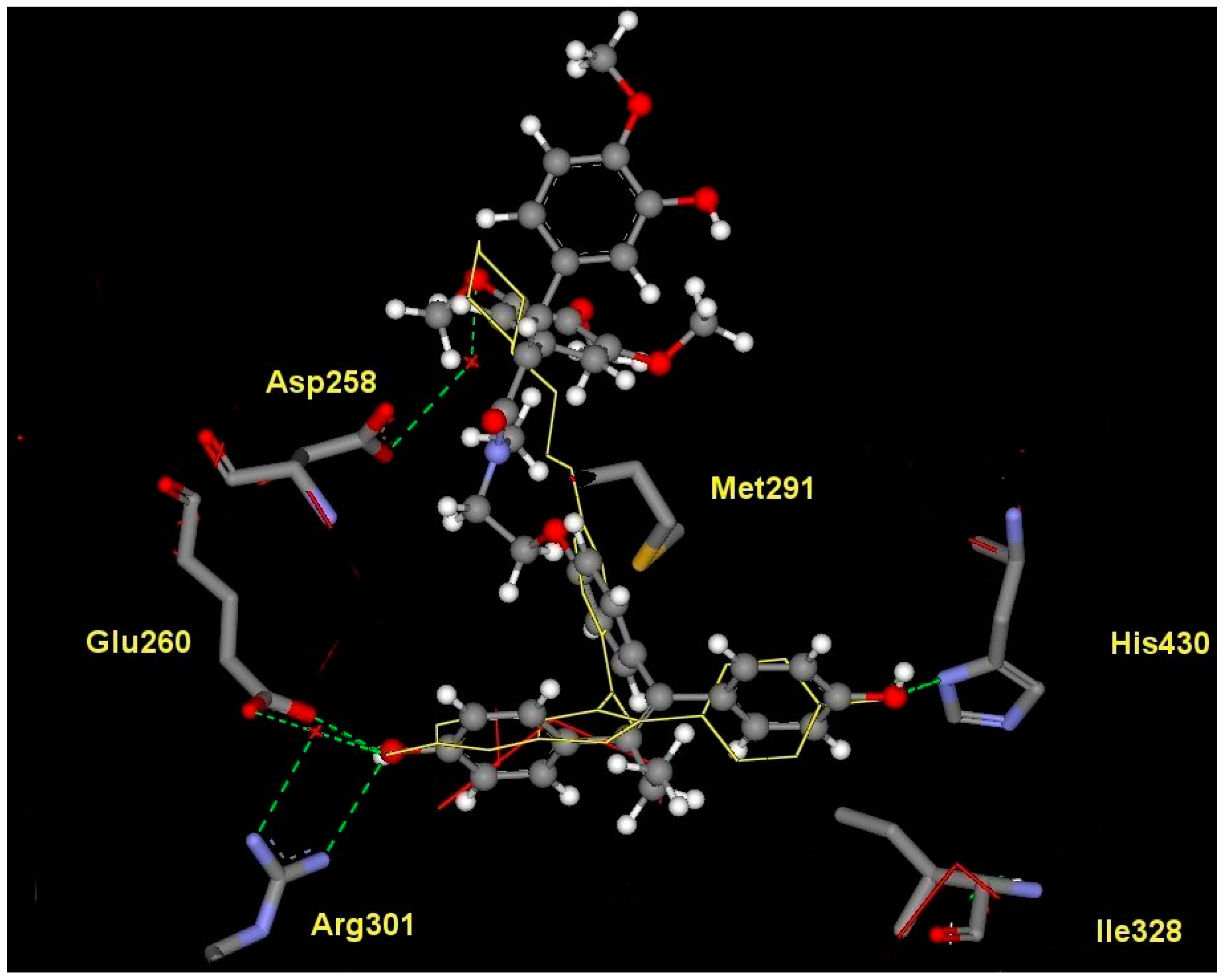
 | ||||||||
|---|---|---|---|---|---|---|---|---|
| Compound | R1 | R2 | R3 | R4 | R5 | R6 | R7 | IC50 (μM) b |
| 13 | COOH | H | OMe | OMe | OMe | OMe | OH | 0.120 |
| 14 | COOH | H | OMe | OMe | OMe | OMe | H | 7.80 |
| 15 | COOH | H | OMe | OMe | OMe | OMe | F | 55.1 |
| 16 | COOH | H | OMe | OMe | OMe | OMe | NH2 | 6.70 |
| 17 | COOH | H | OMe | OMe | OMe | Br | H | >50 |
| 18 | COOH | H | OMe | OMe | OMe | F | H | >50 |
| 19 | COOH | H | OMe | OMe | OMe | Me | H | 26.1 |
| 20 | COOH | H | OMe | OMe | OMe | SMe | H | 10.6 |
| 21 | COOH | H | OMe | OMe | OMe | OMe | NO2 | 2.50 |
| 22 | COOH | H | OMe | OMe | OMe | -C4H4- | 15.3 | |
| 23 | H | COOH | OMe | OMe | OMe | OMe | H | >50 |
| 24 | CO2Me | H | OMe | OMe | OMe | OMe | OH | 2.80 |
| 25 | H | COOH | -OCH2O- | H | OMe | H | >50 | |
| 47 | H | CO-Pi | OMe | OMe | OMe | OMe | H | > 50 |
| 48 | H | CO-Py | OMe | OMe | OMe | OMe | H | >50 |
| 49 | CO-Pi e | H | OMe | OMe | OMe | OMe | OH | >50 |
| 52 | CO-Py f | H | OMe | OMe | OMe | OMe | H | >50 |
| 53 | CO-Pi e | H | OMe | OMe | OMe | OMe | H | g |
| 54 | CO-Py f | H | OMe | OMe | OMe | OMe | NH2 | >50 |
| 55 | CO-Pi e | H | OMe | OMe | OMe | OMe | NH2 | h |
| 26 (CA4) c | H | H | OMe | OMe | OMe | OMe | OH | 0.008 |
| 11 d | H | - | - | - | - | - | - | 0.029 |
| 12 | OH | - | - | - | - | - | - | 0.028 |
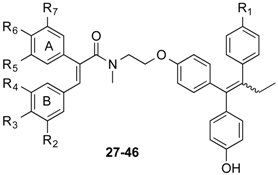 | |||||||||
|---|---|---|---|---|---|---|---|---|---|
| Compound | R1 | R2 | R3 | R4 | R5 | R6 | R7 | IC50 (μM) b | % Cell Death at 10 μM c |
| 27 | H | OH | OMe | H | OMe | OMe | OMe | 0.033 | 10 |
| 28 | OH | OH | OMe | H | OMe | OMe | OMe | 0.005 | 17 |
| 29 | H | H | OMe | H | OMe | OMe | OMe | 0.087 | 12 |
| 30 | OH | H | OMe | H | OMe | OMe | OMe | 0.043 | 19 |
| 31 | H | OMe | OMe | OMe | H | OMe | H | 2.08 | 1 |
| 32 | OH | OMe | OMe | OMe | H | OMe | H | 0.041 | 16 |
| 33 | H | -OCH2O- | H | H | OMe | H | 1.47 | 8 | |
| 34 | OH | -OCH2O- | H | H | OMe | H | 0.049 | 6 | |
| 35 | H | -C4H4- | H | OMe | OMe | OMe | 1.51 | 0 | |
| 36 | OH | -C4H4- | H | OMe | OMe | OMe | 3.62 | 3 | |
| 37 | H | H | Me | H | OMe | OMe | OMe | 1.75 | 2 |
| 38 | OH | H | Me | H | OMe | OMe | OMe | 0.372 | 12 |
| 39 | H | H | SMe | H | OMe | OMe | OMe | 0.790 | 3 |
| 40 | OH | H | SMe | H | OMe | OMe | OMe | 0.064 | 2 |
| 41 | H | H | Br | H | OMe | OMe | OMe | 1.03 | 5 |
| 42 | OH | H | Br | H | OMe | OMe | OMe | 2.35 | 7 |
| 43 | H | F | OMe | H | OMe | OMe | OMe | 0.180 | 2 |
| 44 | OH | F | OMe | H | OMe | OMe | OMe | 0.194 | 10 |
| 45 | H | NH2 | OMe | H | OMe | OMe | OMe | 0.959 | 8 |
| 46 | OH | NH2 | OMe | H | OMe | OMe | OMe | 6.15 | 6 |
| 26 (CA4) d | - | - | - | - | - | - | - | 0.008 | 13 |
| 11 e | - | - | - | - | - | - | - | 0.029 | 23 |
| 12 | - | - | - | - | - | - | - | 0.028 | 11 |
 | |||||||||
|---|---|---|---|---|---|---|---|---|---|
| Compound | R1 | R2 | R3 | R4 | R5 | R6 | R7 | IC50 (μM) b | % Cell Death at 10 μM c |
| 27 | H | OH | OMe | H | OMe | OMe | OMe | 2.67 | 17 |
| 28 | OH | OH | OMe | H | OMe | OMe | OMe | 2.48 | 15 |
| 29 | H | H | OMe | H | OMe | OMe | OMe | 30.6 | 2 |
| 30 | OH | H | OMe | H | OMe | OMe | OMe | 6.29 | 7 |
| 31 | H | OMe | OMe | OMe | H | OMe | H | 51.0 | 0 |
| 32 | OH | OMe | OMe | OMe | H | OMe | H | 4.09 | 0 |
| 33 | H | OCH2O | H | H | OMe | H | 5.23 | 0 | |
| 34 | OH | OCH2O | H | H | OMe | H | 0.68 | 16 | |
| 35 | H | -C4H4- | H | OMe | OMe | OMe | 2.16 | 0 | |
| 36 | OH | -C4H4- | H | OMe | OMe | OMe | 4.32 | 0 | |
| 41 | H | H | Br | H | OMe | OMe | OMe | >50 | 0 |
| 42 | OH | H | Br | H | OMe | OMe | OMe | >50 | 9 |
| 43 | H | F | OMe | H | OMe | OMe | OMe | 30.3 | 0 |
| 44 | OH | F | OMe | H | OMe | OMe | OMe | 1.85 | 14 |
| 45 | H | NH2 | OMe | H | OMe | OMe | OMe | 7.11 | 0 |
| 46 | OH | NH2 | OMe | H | OMe | OMe | OMe | 49.7 | 0 |
| Tamoxifen | 20 | 0 | |||||||
| Hydroxytamoxifen | 18 | 0 | |||||||
| 26 (CA4) | 0.043 | 4 | |||||||
 | |||
|---|---|---|---|
| Compound | IC50 (nM) a,b | Selectivity (α/β) | |
| ERα | ERβ | ||
| 28 | 1 | 5 | 5.22 |
| 11 (Endoxifen) | 47 | 118 | 2.52 |
| 12 (Hydroxyendoxifen) | 44 | 40 | 0.90 |
| 4-Hydroxytamoxifen | 30 | 26 | 0.88 |
| Estradiol | 6 | 6 | 0.98 |
| Cell Line | Compound 28 | Compound 28 | CELL LINE | Compound 28 | Compound 28 |
|---|---|---|---|---|---|
| GI% (10−5 M) a | GI50 (μM) b | GI% (10−5 M) a | GI50 (μM) b | ||
| Leukemia | Melanoma | ||||
| CCRF-CEM | 72.48 | 1.77 | LOX IMV1 | 1.55 | 87.57 |
| HL-60 (TB) | 100 d,f | 1.4 | MALME-3M | 1.76 | 76.76 |
| K-562 | 86.1 | 2.57 | M14 | 1.68 | 100 d,p |
| MOLT-4 | 64.31 | 1.52 | MDA-MB-235 | 0.747 | 90.98 |
| RPMI-8226 | 90.65 | 0.896 | SK-MEL-2 | 8.67 | 97.42 |
| SR | 69.03 | 2.35 | SK-MEL-28 | 1.65 | 76.19 |
| Non-Small Cell Lung Cancer | SK-MEL-5 | 0.837 | 100 d,q | ||
| A549/ATCC | 86.97 | 2.88 | UACC-257 | 2.83 | 100 d,r |
| EKVX | 85.11 | 2.01 | UACC-62 | 0.922 | 100 d,s |
| HOP-62 | 81.99 | 2.86 | Ovarian Cancer | ||
| HOP-92 | 86.19 | 0.764 | IGROV1 | 2.3 | 100 d,t |
| OVCAR-3 | 1 | 100 d,u | |||
| NCI-H226 | 100 d,g | 1.18 | OVCAR-4 | 2.59 | 81.47 |
| NCI-H23 | 96.76 | 2.19 | OVCAR-5 | 3.21 | 82.75 |
| NCI-H332M | 81.7 | 2.02 | OVCAR-8 | 2.02 | 97.21 |
| NCI-H460 | 98.38 | 1.42 | NCI/ADR-RES | 6.02 | 21.31 |
| NCI-H552 | 100 d,h | 1.39 | SK-OV-3 | 1.66 | 95.08 |
| Colon Cancer | Renal Cancer | ||||
| COLO 205 | 100 d,i | 2.15 | 786-0 | 1.91 | 100 d,v |
| HCT-2998 | 100 d,j | 1.25 | A498 | 2.94 | 80.37 |
| HCT-116 | 97.57 | 1.8 | ACHN | 1.92 | 96.43 |
| HCT-15 | 100 d,k | 1.53 | CAKI-1 | 1 | 91.46 |
| HT29 | 100 d,l | 1.16 | RXF 393 | 1.89 | 95.02 |
| KM12 | 100 d,m | 1.26 | SN12C | 1.8 | 90.3 |
| SW-620 | 81.32 | 1.21 | TK-10 | 1.65 | 100 d,w |
| CNS Cancer | UO-31 | 2.66 | 89.77 | ||
| SF-268 | 84.22 | 1.69 | Breast Cancer | ||
| SF295 | 73.4 | 1.74 | MCF-7 | 0.00998 | 94.3 |
| SF539 | 100 d,n | 1.18 | MDA-MB-231/ATCC | 1.61 | 73.55 |
| SNB-19 | 81.49 | 1.72 | HS 578T | 2.04 | 64.8 |
| SNB-75 | 60.65 | 5.96 | BT-549 | 1.12 | 100 d,x |
| U251 | 93.37 | 1.74 | T-47D | Nd c | 100 d,y |
| Prostate cancer | MDA-MB-468 | 1.12 | 100 d,z | ||
| PC-3 | 86.32 | 1.73 | |||
| DU-145 | 100 d,o | 1.66 | |||
| MG-MID (µM) e | 1.45 |
© 2016 by the authors. Licensee MDPI, Basel, Switzerland. This article is an open access article distributed under the terms and conditions of the Creative Commons Attribution (CC-BY) license ( http://creativecommons.org/licenses/by/4.0/).
Share and Cite
Keely, N.O.; Carr, M.; Yassin, B.; Ana, G.; Lloyd, D.G.; Zisterer, D.; Meegan, M.J. Design, Synthesis and Biochemical Evaluation of Novel Selective Estrogen Receptor Ligand Conjugates Incorporating an Endoxifen-Combretastatin Hybrid Scaffold. Biomedicines 2016, 4, 15. https://doi.org/10.3390/biomedicines4030015
Keely NO, Carr M, Yassin B, Ana G, Lloyd DG, Zisterer D, Meegan MJ. Design, Synthesis and Biochemical Evaluation of Novel Selective Estrogen Receptor Ligand Conjugates Incorporating an Endoxifen-Combretastatin Hybrid Scaffold. Biomedicines. 2016; 4(3):15. https://doi.org/10.3390/biomedicines4030015
Chicago/Turabian StyleKeely, Niall O., Miriam Carr, Bassem Yassin, Gloria Ana, David G. Lloyd, Daniela Zisterer, and Mary J. Meegan. 2016. "Design, Synthesis and Biochemical Evaluation of Novel Selective Estrogen Receptor Ligand Conjugates Incorporating an Endoxifen-Combretastatin Hybrid Scaffold" Biomedicines 4, no. 3: 15. https://doi.org/10.3390/biomedicines4030015






